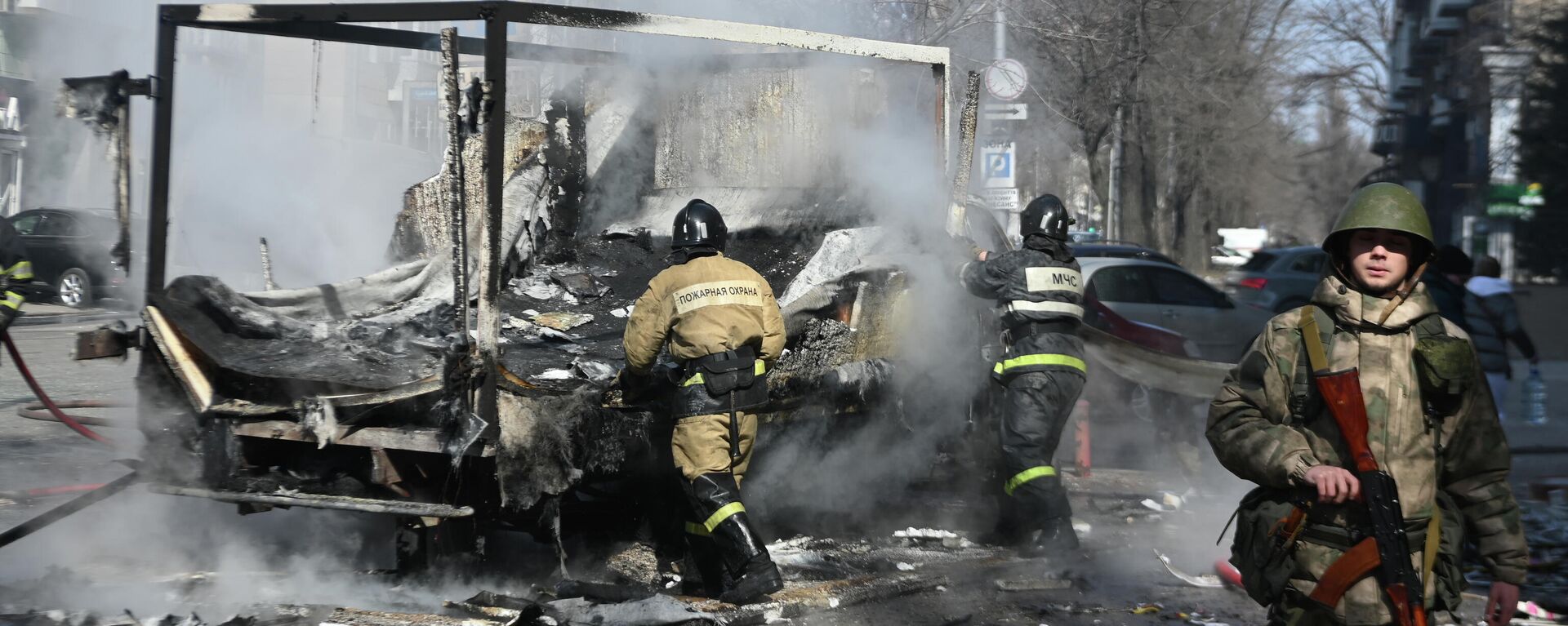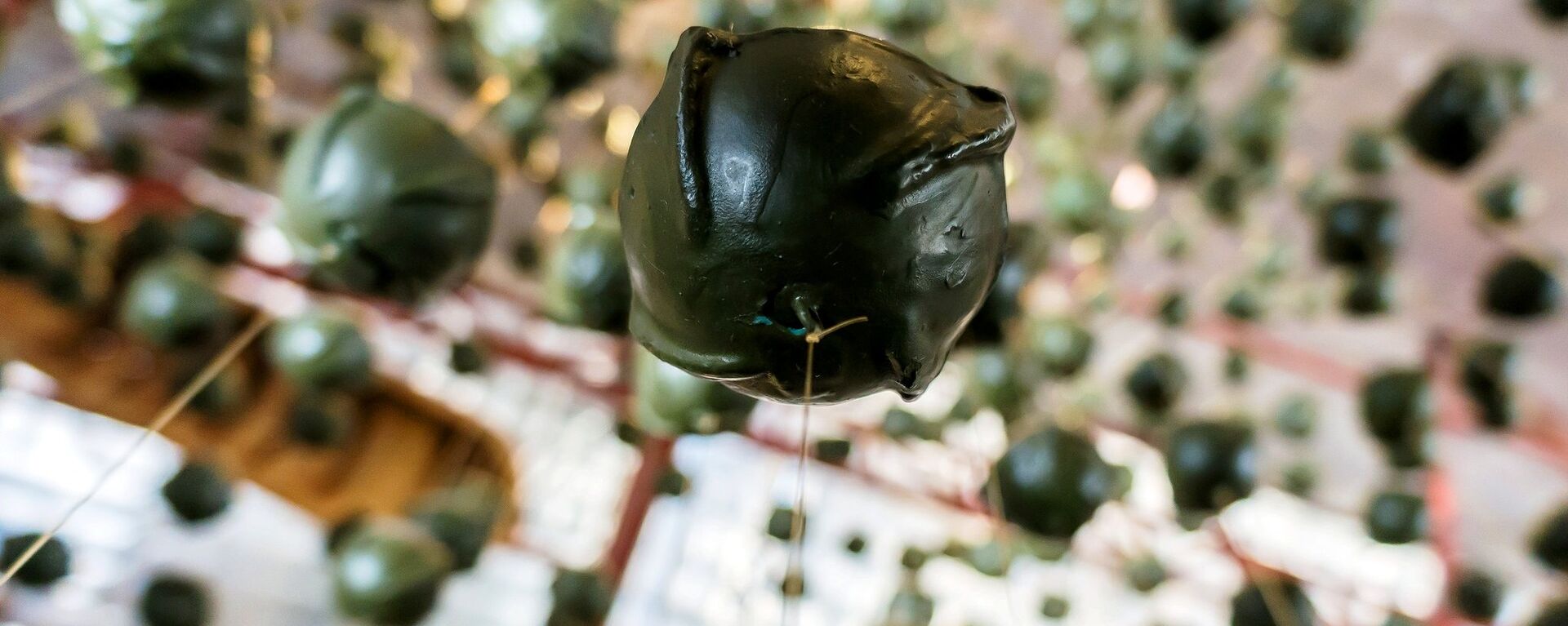https://sputnikglobe.com/20230708/everything-you-need-to-know-about-cluster-bombs-the-us-will-send-to-ukraine-1111735880.html
Everything You Need to Know About Cluster Bombs US Will Send to Ukraine
Everything You Need to Know About Cluster Bombs US Will Send to Ukraine
Sputnik International
The United States announced on Friday that it would send cluster munitions to Ukraine, despite their ban by other NATO members
2023-07-08T02:09+0000
2023-07-08T02:09+0000
2023-07-08T04:39+0000
cluster bombs
cluster munitions
joe biden
volodymyr zelensky
russia
ukraine
nato
defense department
sputnik explains
https://cdn1.img.sputnikglobe.com/img/105986/90/1059869037_0:936:2048:2088_1920x0_80_0_0_9b8f62a310781cb975a5b8b3d94044d3.jpg
In general, cluster munitions refer to any kind of shell that opens in the air and releases a number of smaller explosives, called “bomblets” over a larger area. They can be made to be fired by artillery, naval guns, rocket launchers, or dropped from a plane.Their use is condemned by many international human rights organizations since some of the bomblets dropped by cluster munitions, as high as 40% of them, fail to explode when fired. As such, the bomblets fall to the ground and act as landmines, capable of killing civilians for years or decades later.What Type of Cluster Munitions Will the US Send?The specific type of cluster munitions being sent to Ukraine are from a stockpile of Dual-Purpose Improved Conventional Munitions, or DPICMs, that the US military previously pledged to destroy. They can be fired from 155mm Howitzers and carry 88 bomblets inside their containers, each with a 10 square meters lethal range. A single canister can cover a 30,000-square-meter area.While Pentagon Press Secretary Brig. Gen. Patrick Ryder told reporters on Thursday that the weapons have less than a 2.35% unexploded ordnance rate, the supervisory organization contends the weapons are over 20 years old and have a notoriously high rate of unexploded ordnance.What's the History of US Policy Regarding Cluster Munitions?The United States has, at times, talked about ending its use of cluster munitions. A 2008 Defense Department directive signed by former US President George W. Bush instructed the military to remove all but a tiny fraction of its cluster munition arsenal by 2018 until safer versions, with an unexploded ordnance rate of under 1%, could be created. After the Pentagon failed to develop reliable cluster munitions despite investing millions of dollars, then-President Donald Trump rescinded the Bush-era order in 2017.While cluster munitions were used as far back as World War II, the United States infamously used them extensively during the Vietnam War, including in secret illegal operations in Laos. Around 20,000 people, 40% of them children, have been killed or injured in Laos from unexploded cluster bomblets since the war ended.Cluster munitions were also used by the United States in Cambodia, Grenada, Lebanon, Libya, Iran, Afghanistan and during both Iraq wars, where they killed civilians and US military personnel.Does the US Still Use Cluster Bombs?The last confirmed use of cluster munitions by the United States occurred in Yemen in 2009; however, they were last used in large numbers by the US government during the invasion of Iraq and in Afghanistan.There have also been reports the US continued to make cluster munitions until 2016, and evidence that the Saudi-led coalition used cluster munitions supplied by the United States in its war against Houthi forces in Yemen.Have Cluster Munitions Been Used In Ukraine Already?Ukraine first used cluster munitions in 2014 against people of Donbass. According to the UN, Ukrainian forces used cluster munitions in highly populated areas in and around Donetsk less than a month after signing the 2014 Minsk Agreement. Ukraine denied the accusations at the time.According to the United Nations, Ukraine also utilized cluster bombs over civilian areas in and around the city of Izium over multiple days in 2022 while it was under Russian control. Despite clear evidence and more than 100 interviewed witnesses who confirmed it, Ukraine issued a short statement denying it used cluster munitions in and around the area without addressing the evidence.Why Are Cluster Munitions Being Sent Now?It's suggested cluster munitions are part of the US military aid package largely because the much-hyped Ukrainian counteroffensive has been viewed as an overwhelming dud to date. Ukraine and the United States hyped the offensive for months but after several delays, it has failed to create any major advances more than a month into the operation.The NATO summit meeting in Vilnius will take place on July 11-12. There, the United States and Ukrainian President Volodymyr Zelensky, who has been invited to the summit, are expected to pressure NATO allies to provide more aid and weapons to Ukraine.
https://sputnikglobe.com/20230707/antonov-us-approval-of-cluster-bombs-for-ukraine-bringing-humanity-closer-to-world-war-1111733750.html
https://sputnikglobe.com/20220314/children-among-victims-as-ukrainian-military-attacked-donetsk-with-tochka-u-missile-dpr-head-says-1093854330.html
https://sputnikglobe.com/20230707/cluster-munitions-transfer-shows-how-us-ukraine-have-grown-desperate-amid-conflict-1111734380.html
russia
ukraine
Sputnik International
feedback@sputniknews.com
+74956456601
MIA „Rossiya Segodnya“
2023
News
en_EN
Sputnik International
feedback@sputniknews.com
+74956456601
MIA „Rossiya Segodnya“
Sputnik International
feedback@sputniknews.com
+74956456601
MIA „Rossiya Segodnya“
cluster bombs to the ukraine, us sending cluster munitions,
cluster bombs to the ukraine, us sending cluster munitions,
Everything You Need to Know About Cluster Bombs US Will Send to Ukraine
02:09 GMT 08.07.2023 (Updated: 04:39 GMT 08.07.2023) US President Joe Biden confirmed on Friday that the US will deliver cluster munitions, also called cluster bombs, to Ukraine for use against Russia during its special military operation. The move comes despite the US' past condemnation of the weaponry's use.
In general, cluster munitions refer to any kind of shell that opens in the air and releases a number of smaller explosives, called “bomblets” over a larger area. They can be made to be fired by artillery, naval guns, rocket launchers, or dropped from a plane.
Their use is condemned by many international human rights organizations since some of the bomblets dropped by cluster munitions, as high as 40% of them, fail to explode when fired. As such, the bomblets fall to the ground and act as landmines, capable of killing civilians for years or decades later.
What Type of Cluster Munitions Will the US Send?
The specific type of cluster munitions being sent to Ukraine are from a stockpile of Dual-Purpose Improved Conventional Munitions, or DPICMs, that the US military previously pledged to destroy. They can be fired from 155mm Howitzers and carry 88 bomblets inside their containers, each with a 10 square meters lethal range. A single canister can cover a 30,000-square-meter area.
While Pentagon Press Secretary Brig. Gen. Patrick Ryder told reporters on Thursday that the weapons have less than a 2.35% unexploded ordnance rate, the supervisory organization contends the weapons are over 20 years old and have a notoriously high rate of unexploded ordnance.
What's the History of US Policy Regarding Cluster Munitions?
The United States has, at times, talked about ending its use of cluster munitions. A 2008 Defense Department directive signed by former US President George W. Bush instructed the military to remove all but a tiny fraction of its cluster munition arsenal by 2018 until safer versions, with an unexploded ordnance rate of under 1%, could be created. After the Pentagon failed to develop reliable cluster munitions despite investing millions of dollars, then-President Donald Trump rescinded the Bush-era order in 2017.
The order kept in place a provision that prohibited the export of cluster munitions with an unexploded ordnance rate over 1% but provided an exception if the president determines there is an “extraordinary need” for them and the receiving country pledges not to use them in civilian areas.
While cluster munitions were used as far back as World War II, the United States infamously used them extensively during the Vietnam War, including in secret illegal operations in Laos. Around 20,000 people, 40% of them children, have been killed or injured in Laos from unexploded cluster bomblets since the war ended.
Cluster munitions were also used by the United States in Cambodia, Grenada, Lebanon, Libya, Iran, Afghanistan and during both Iraq wars, where they killed civilians and US military personnel.
Does the US Still Use Cluster Bombs?
The last confirmed use of cluster munitions by the United States occurred in Yemen in 2009; however, they were last used in large numbers by the US government during the invasion of Iraq and in Afghanistan.
There have also been reports the US continued to make cluster munitions until 2016, and evidence that the Saudi-led coalition used cluster munitions supplied by the United States in its war against Houthi forces in Yemen.
Have Cluster Munitions Been Used In Ukraine Already?
Ukraine first used cluster munitions in 2014 against people of Donbass. According to the UN, Ukrainian forces used cluster munitions in highly populated areas in and around Donetsk less than a month after signing the 2014 Minsk Agreement. Ukraine denied the accusations at the time.
According to the United Nations, Ukraine also utilized cluster bombs over civilian areas in and around the city of Izium over multiple days in 2022 while it was under Russian control. Despite clear evidence and more than 100 interviewed witnesses who confirmed it, Ukraine issued a short statement denying it used cluster munitions in and around the area without addressing the evidence.
Why Are Cluster Munitions Being Sent Now?
It's suggested cluster munitions are part of the US military aid package largely because the much-hyped Ukrainian counteroffensive has been viewed as an overwhelming dud to date. Ukraine and the United States hyped the offensive for months but after several delays, it has failed to create any major advances more than a month into the operation.
The NATO summit meeting in Vilnius will take place on July 11-12. There, the United States and Ukrainian President Volodymyr Zelensky, who has been invited to the summit, are expected to pressure NATO allies to provide more aid and weapons to Ukraine.




